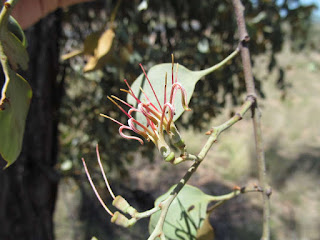We are back now, so this post will cover the rest of our trip in one go.
Another nice waterfall, the Dangar falls north of Dorrigo. Later we passed two more little waterfalls, Sherrard and Newell Falls, but they were directly on the Dorrigo-Bellingen road and thus not easy to photograph.
A theme of this last part of our trip was giant tree tourism. Above is the Giant Tallowood (
Eucalyptus microcorys) east of Megan. A sign announced that it had a diametre of 3.14 m and a height of 56.5 m. I do not know what the virtues of its wood are, but the locals appear to consider the species to be very significant, as one can see a Tallowood Cafe and suchlike.
After spending a night in pleasant little Bellingen - the most hippie town I have ever seen in Australia - we were essentially on our way back. We left the New England area even in the loosest sense and drove south along the coast. But before driving through in a dedicated manner we spent some time in the vicinity of Laurieton. This is another town that I can only recommend - our motel, the Indian restaurant in the centre, and the surrounding landscape were all extremely enjoyable.
As for that landscape, the area has three forested hills that are so similar that they were named the Three Brothers. The above picture shows Laurieton as seen from the North Brother in Dooragan National Park.
The rainforest on the southern slopes of the North Brother was amazing. I would not have thought to find strangler figs and well-developed Brettwurzeln (buttress roots) so far south of the tropics. There were massive tree ferns and slender palms, epiphytic ferns we had not seen before, and trees with wonderfully soft, corky bark. The picture here shows another very odd plant:
Gymnostachys anceps. Although its overall habit immediately suggests a sedge, it is of the arum family Araceae.
To give more of an idea of the overall landscape, this is a view from Donbogan Lookout in Kattang Nature Reserve, with the base of the North Brother just reaching into the picture from the right.
In Middle Brother National Park we then continued our giant tree tourism. Shown here is the Bird Tree, considered to be the largest tree in New South Wales by volume. Unfortunately there was no sign providing its measurements or species name...
...but it is surely an impressive specimen! Interestingly, there were quite a few other visitors, whereas the Giant Tallowood did not have any apart from us. Then again, that was during the week, and we saw the Bird Tree on a long weekend, so who knows.


















































